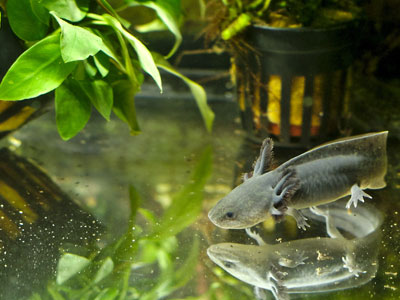
Axolotls accommodate well to being raised and bred in captivity. Their housing requirements aren’t complicated, and enthusiasts can generally do a good job at offering their axolotls conditions that closely mimic their natural habitat.
If you’re new to axolotls and you’re considering raising one yourself, in this article I’ll talk about getting started with your axolotl aquarium including tank size requirements, aquarium equipment, and water chemistry considerations.
If you’re a bit overwhelmed at the beginning, don’t worry, you’ll do fine as long as you’re willing to learn and inform yourself about all aspects related to caring for axolotls.
How to Set Up Axolotl Aquarium?
If it’s your first time ever setting up an aquarium, you’ll need to familiarize yourself with the nitrogen cycle, which is the very first step in axolotl care.
Cycling your aquarium (i.e. establishing a colony of healthy bacteria that will transform toxins into less harmful substances) is one of the most important things you can do to give your axolotl a great start in life.
I encourage you to read up on how to carry out the nitrogen cycle for a freshwater aquarium and allow the cycle to complete as naturally as possible.
The nitrogen cycle can take a while, so don’t lose patience and keep on measuring for ammonia, nitrites and nitrates until you complete the cycle.
Only after you’ve carried out the nitrogen cycle and all water chemistry measurements turn out good can you add axolotls to the aquarium.
If the water you use in the aquarium comes from the tap, you should dechlorinate it by using special water conditioners that can neutralize chloramine too, depending on the type of water disinfectant used by your water provider.
This is something to bear in mind even for the regular water changes you’ll be performing since both chlorine and chloramine are toxic for your axolotl.
Before you can perform the nitrogen cycle, you’ll first need an aquarium and aquarium equipment, so that when the nitrogen cycle is completed, everything is ready for your axolotl to take up residence in the new tank.
In what follows, I’ll discuss the tank size recommended for axolotls, the equipment that’s necessary for an axolotl aquarium, and other aspects recommended for setting up an axolotl aquarium.
Tank Size
When you get your axolotl, most likely it will be a juvenile axolotl and you may be led to believe that your axie will do just fine in a small tank.
And while that may be correct for now, remember that axolotls can grow to be up to 14 inches. Now, not all axolotls will grow to be this big, but you should still keep this in mind when choosing a tank.
You may have read that a 10 gallon aquarium is the minimum you should consider for a single axolotl. This may be all right, but I’d definitely go for a bigger tank, especially if you’re a beginner aquarist.
Managing water chemistry matters in a small tank environment can be more challenging compared to a bigger aquarium. Toxin levels can quickly spike in a small tank and they’re harder to control.
Not to mention that axolotls have a high bioload, so regular water changes along with a close monitorization of the water chemistry is crucial to avoid issues related to toxin levels.
Therefore, a 15 to 20-gallon aquarium would be ideal for an axolotl considering their size in adulthood and their bioload.
Simply fill up the tank as you would for a regular fish aquarium and get started on the nitrogen cycle as soon as possible.
Aquarium Equipment You’ll Need
Some of the aquarium equipment I discuss below are necessary to ensure the safety and comfort of your axolotl, others are optional or serve decorative purposes only.
Let’s see which are some of the essential equipment you’ll need and some of the equipment that’s only optional:
Aquarium Hood or Mesh Lid
An aquarium hood may not be the first thing that comes to mind when setting up your axolotl aquarium but having some sort of aquarium cover for your axolotl tank is essential.
Axolotls get into the habit of jumping out of the aquarium, which can result in injuries sustained because of the fall, or even death from said injuries as well as death because of dehydration.
To prevent this from happening, don’t skimp on an aquarium cover because you might end up regretting it later.
An aquarium hood or mesh lid is an inexpensive addition to your aquarium. I prefer having a mesh lid because it aids water evaporation, which helps cool the water in the aquarium.
If temperature spikes aren’t a concern in your area and you can manage to keep the water at the temperature required for axolotls all year round (especially if you have an aquarium chiller), you can go with an aquarium hood instead.
Either way, get an aquarium cover to prevent unfortunate accidents related to axolotls jumping out of the aquarium.
Water Testing Kit
A water testing kit that measures toxin levels (ammonia, nitrites, nitrates) and water pH will be helpful in monitoring the progress you’re making with the nitrogen cycle.
The testing kit will be useful even later on in monitoring the water chemistry and determining the frequency of water changes in your aquarium.
A water testing kit is one of the first things you’ll need to buy for your aquarium.
Thermometer
A thermometer is another necessary piece of equipment for your axolotl aquarium. If you can, I recommend getting one that measures both the water temperature and the air temperature so you can get a better handle on things, especially when it comes to cooling the water in the aquarium.
Axolotls do best in cold temperature water, and you may need to cool the axolotl aquarium by various means during summer heat waves (such as ice packs, ice jugs, air conditioning, fans and other cooling systems).
The ideal temperature range for axolotls is between 60-64 F (16 and 18 C). It can be difficult to keep the water at this temperature in areas with very warm summers.
Unfortunately, axolotls don’t tolerate temperature fluctuations, so keeping an eye on the water temperature and monitoring temperature changes can help avoid issues down the line.
Even a temperature fluctuation of a few degrees Celsius during a 12-hour period can trigger stress, therefore, even though temperatures may fluctuate from season to season, daily fluctuations should be avoided.
An aquarium thermometer will help you monitor the temperature and make any adjustments in time should deviations from the ideal range occur.
Hang-On-Back Filter (with Spray Bar)
If you’re not averse to doing daily water changes, you may get away with not using an aquarium filter, but it’s unlikely that you’ll find the time to perform a partial water change every day.
I strongly recommend investing in an aquarium filter for your axolotl tank. It can go a long way in keeping the water chemistry stable and the water clear.
For best results, get one that offers biological, mechanical and chemical filtration. Aquarium filters with biological filtration allow the colonization with beneficial bacteria, mechanical filtration removes suspended solids and particles, while chemical filtration removes any residual chlorine or chloramine.
However, investing in an aquarium filter for your axolotl tank should not be a reason to ever skip weekly water changes, which are an equally integral part of your tank cleaning regimen.
For a 15 to 20-gallon aquarium a HOB filter is enough, you don’t need to get a canister filter, which works best for larger aquariums.
One thing that’s extremely important is having only a gentle current in the aquarium because a strong current will stress out axolotls. You can either place a stone to disperse the outflow of the filter or use a spray bar to achieve the same.
Because strong currents are a stress trigger for axolotls, it’s best to reduce the current either by setting your filter to a gentler flow setting or using something to disperse the flow.
Hiding Spots
Hiding spots are useful when housing more than one axolotl in a single aquarium or when you’re using aquarium lighting.
If there are size differences between your axolotls, the larger ones may bully the smaller ones. Hiding spots like caves and other decorations that offer cover can be a good way to prevent more serious incidents.
Strong aquarium lights can also be a source of stress for axolotls, so having covered areas in the aquarium, where axolotls can hide is also quite useful.
These are the equipment that every axolotl aquarium should have without fail. There is other equipment that can help create a more comfortable or nature-like environment for axolotls, but these are mostly optional.
Optional equipment or aquarium accessories include:
Plants
Live plants certainly look nice in an aquarium, especially if you’re going for an aesthetically pleasing set-up that’s very nature-like.
The problem with live plants is that axolotls are known to uproot them. You can root small plants in small pots, or you can go for floating plants, which usually work best in axolotl tanks.
Live plants are not only pleasing to the eyes but can add a sense of security for your axolotls along with caves and pipes that double as hiding spots.
Live plants are also beneficial to the water chemistry, helping along the nitrogen cycle in the initial phase of the tank set-up and later helping to oxygenate the water.
Decorations
Decorations aren’t something that axolotls especially need, but if you’re going to add some pizzazz to your aquarium, I suggest going with things that don’t have sharp edges and can’t hurt your axolotl.
If they can serve a functional purpose as well (e.g. they can be used as a hiding spot) it’s even better.
Lighting
As I mentioned, axolotls are stressed from strong lights and they prefer only what natural light is available in the room you’re keeping them.
If you have live plants in the aquarium that don’t do well in low light conditions, aquarium lighting can be useful, but you must create a tank environment in which your axolotls can comfortably seek out darker parts of the aquarium.
With these in mind, you can seek out creative ways to create an aquarium that’s both pleasing to your eyes and comfortable for your axolotls.
Substrate Considerations
As you may have noticed, I didn’t mention substrate neither as a necessary nor as an optional element for your axolotl tank.
While substrate isn’t necessary per se, I prefer it to bare-bottom tanks since I’ve noticed that axolotls generally tend to prefer it as well because a good substrate will provide them with a sense of security, plus they get better traction to roam around.
A good substrate will certainly make your tank look better and your axolotl feel more at home. But substrate can be problematic for axies.
For adult axolotls, sand is the only acceptable substrate. Gravel and pebbles are risky, because of the way axolotls feed (they swallow their food whole).
Swallowing a pebble or gravel can spell trouble for your lotl because pieces of gravel or pebble can get stuck in their GI tract and cause impaction, which can be fatal.
Therefore, choose sand for adult axolotls and hold off on adding any substrate (even sand) for baby axolotls because the same problems mentioned for adult axolotls can happen to baby axolotls even if sand is involved. I would hold off on the sand substrate until your axolotls are over 5 inches.
Conclusion
As you can see, it isn’t so difficult to put together an axolotl aquarium. If you have all the equipment ready and you’ve completed the nitrogen cycle, you’re ready to house your axolotl.
By creating tank conditions that work best for your axolotl, you’re on track to offer them a healthy start in life, and by keeping tabs on water parameters and regularly performing water changes, you’ll be able to prevent diseases and stress-induced ailments.
I hope you’re now ready to apply this newfound knowledge on axolotl aquarium set up and you’re ready to offer your axolotl the best care.

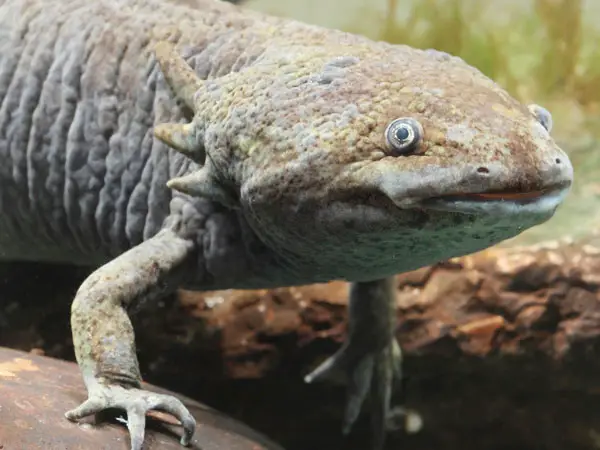
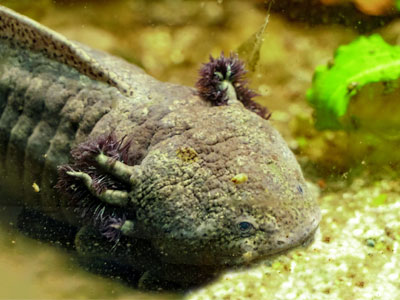
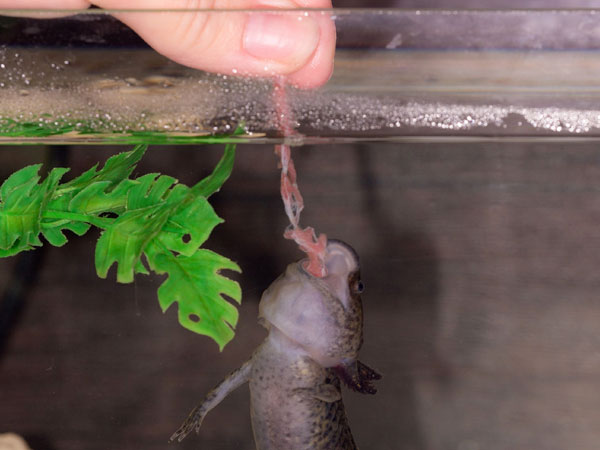
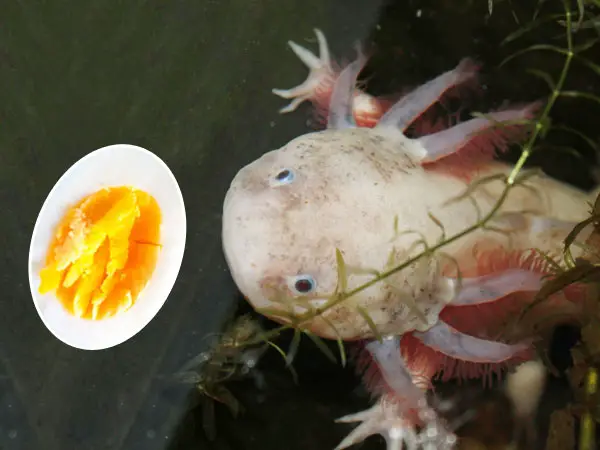
super helpful! if I get a lotl, this will be extremely helpful!! and I also realize that I have some of the materials already! also my room is a good temperature and I keep it ambient so there isn’t strong lights
I bought an Axolotl before realizing you have to cycle the tank! It’s coming in three days. What do I do?!
i love axolotl